

|
Soundclip:
|
| See Steve's Hand-Written Solo
Transcription |
|
Kenny Burrell's solo on: "Stompin' at the Savoy"(Goodman-Sampson-Webb-Razaf) It is rather hard to believe that I am finally sharing a transcription of one of my favorite guitarists of all-time, the great, Kenny Burrell. With such a huge body of work behind him, I suppose it is a bit surprising that I selected his solo on "Stompin' at the Savoy." Which appears on "A GENERATION AGO TODAY"(Verve), and was released in 1967. When I first purchased the LP, I remember being struck by just what an awful cover it was. Perhaps one of the all-time worst Verve covers ever. It has since been re-packaged for the CD format a couple of times, and the version that I have was titled: "FOR CHARLIE AND BENNY" 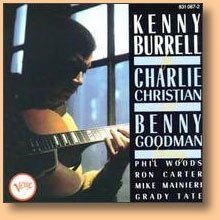 which, of course, refers to Charlie Christian and Benny Goodman. As far as I can tell, that version is no longer available. Fundamentally, the recording, mostly derived from a session in December of 1966, features Kenny in a quartet setting, where the musicians included: Phil Woods: Alto Sax; Ron Carter: Ac. Bass; and Grady Tate: Drums. The recording was beautifully engineered by Rudy Van Gelder, who captures Kenny's wonderful sound as well as anyone. which, of course, refers to Charlie Christian and Benny Goodman. As far as I can tell, that version is no longer available. Fundamentally, the recording, mostly derived from a session in December of 1966, features Kenny in a quartet setting, where the musicians included: Phil Woods: Alto Sax; Ron Carter: Ac. Bass; and Grady Tate: Drums. The recording was beautifully engineered by Rudy Van Gelder, who captures Kenny's wonderful sound as well as anyone.For this presentation, we are offering the one chorus solo that Kenny played, and his portion of the 8's that he traded with Phil Woods. For that portion, Kenny played [A1] and [B]. The 8's followed Woods' one chorus solo. We have condensed both of these solo sections from the transcription into one soundclip via a fade-out, and then, a fade-in. Like most of Creed Taylor's very successful productions of this period, virtually all the tracks on this recording are very, very short, and often not much longer than 3-minutes. So, you would have to look to some of Kenny Burrell's Blue Note recordings to hear more "stretching out." I have to say that I just love the way Kenny begins this solo. It is so very melodic, and sounds completely effortless. It's worth noting that, in the first 3 phrases, the phrase that follows always begins on the note on which the prior phrase ended. If your own soloing lacks a sense of 'flow' you might want to try employing this device as a discipline. Throughout this first [A] section, Kenny's playing is almost completely diatonic, as he employs notes found in the Db major scale. You will only find one altered tone, and that is an A-natural(b9) over the Ab7 chord in bar 6. The relaxed feeling continues in [A2], and there's a nice usage of the 'call and response' device with Kenny answering his own phrase, using his lower register, in bars 2-3. Again, the b9, an A-natural is employed, and that same pitch appears in bar 6. There is also his usage of arpeggiating a portion of the m7(9) chords, in bar 3, as he alludes to a Bbm7 in place of the Bb7(alt.); and in bar 5, this time descending through an Ebm7(9) chord. It is interesting to note that this particular [B] section sounds exactly like a "rhythm changes" bridge, cycling in 4ths. 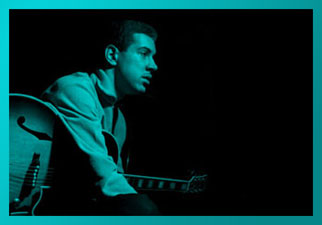 But, were it truly a "rhythm changes" bridge, it would have begun on the III7 chord which, in this key would be an F7 chord. However, this bridge begins the cycle on the IV7 chord, Gb7. It is important to be familiar with the melody of this particular [B] section, because it will help you in understanding some of what Kenny plays here. During the first bar of each of the first 3 chords in the section, the melody and corresponding chord changes go up a half-step: Gb7(G7); B7(C7); and E7(F7). Kenny treats the first 2 bars by implying a sense of Dbm7 over the Gb7 area. You see a nice usage of the classic descending minor 7th line from the root: Db-C-Cb-Bb. Over the B7 chord, he begins by giving one the impression that he is relating to this chord more as being in the key of E major, rather than thinking of it as B Mixolydian or F# Dorian. However, the usage of the A-natural(the 7th), as the line ends, definitely gives it more of a dominant feeling. Over the E7 chord, you can hear and see that Kenny is utilizing the harmonic movement contained in the melody, as I alluded to earlier. As I stated the chord, 1/2-step about E7 is F7, and its corresponding Dorian area would be C Dorian. In the 2nd-half of bar 5 you see the descending notes: G-Eb-D-C, and this is a clear indication that Kenny is 1/2-step above the center. Had he played more choruses, I am certain that you would have seen this device several more times. I would also want to point out a small flaw in execution which occurs in bar 7. It is the kind of 'missed note' that happens to all of us, and it can happen during the recording process as well. Instead of the note speaking as we would want, all that comes out is a 'clicking' sound. I am only pointing this out because hearing that, a wonderful player like Kenny Burrell can have this happen too, gives the rest of us some hope. So, Ye who art downhearted, take hope!!! But, were it truly a "rhythm changes" bridge, it would have begun on the III7 chord which, in this key would be an F7 chord. However, this bridge begins the cycle on the IV7 chord, Gb7. It is important to be familiar with the melody of this particular [B] section, because it will help you in understanding some of what Kenny plays here. During the first bar of each of the first 3 chords in the section, the melody and corresponding chord changes go up a half-step: Gb7(G7); B7(C7); and E7(F7). Kenny treats the first 2 bars by implying a sense of Dbm7 over the Gb7 area. You see a nice usage of the classic descending minor 7th line from the root: Db-C-Cb-Bb. Over the B7 chord, he begins by giving one the impression that he is relating to this chord more as being in the key of E major, rather than thinking of it as B Mixolydian or F# Dorian. However, the usage of the A-natural(the 7th), as the line ends, definitely gives it more of a dominant feeling. Over the E7 chord, you can hear and see that Kenny is utilizing the harmonic movement contained in the melody, as I alluded to earlier. As I stated the chord, 1/2-step about E7 is F7, and its corresponding Dorian area would be C Dorian. In the 2nd-half of bar 5 you see the descending notes: G-Eb-D-C, and this is a clear indication that Kenny is 1/2-step above the center. Had he played more choruses, I am certain that you would have seen this device several more times. I would also want to point out a small flaw in execution which occurs in bar 7. It is the kind of 'missed note' that happens to all of us, and it can happen during the recording process as well. Instead of the note speaking as we would want, all that comes out is a 'clicking' sound. I am only pointing this out because hearing that, a wonderful player like Kenny Burrell can have this happen too, gives the rest of us some hope. So, Ye who art downhearted, take hope!!!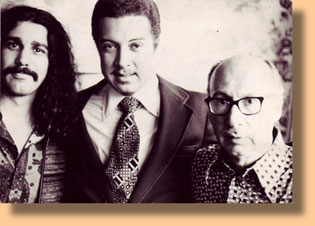 The final 8 for [A3] of this all too brief solo, Kenny's bluesy roots come right to the fore. He shows just how very comfortable he is in using the blues language over major chords and ii-Vs. You hear this in bars 1-3 and again in bars 6-8. In bar 4, over the Bb7(alt.) chord, there is a nice touch to his line where a Cb(b9) is introduced before he uses a short blues-based phrase to descend to Gb, the m3rd of Ebm7. In bars 6-7, Kenny uses the Db minor pentatonic[Db, Fb, Gb, Ab, Cb] as opposed to the Db blues scale. Notice that when he does play the 3rd(F-natural) of Db major, he also glisses up to it because to hit right on it would be very 'vanilla' sounding!!! Had you done that, someone might have turned to you and said, "C'mon, put some grease on that note!" And they would be right!!! The final 8 for [A3] of this all too brief solo, Kenny's bluesy roots come right to the fore. He shows just how very comfortable he is in using the blues language over major chords and ii-Vs. You hear this in bars 1-3 and again in bars 6-8. In bar 4, over the Bb7(alt.) chord, there is a nice touch to his line where a Cb(b9) is introduced before he uses a short blues-based phrase to descend to Gb, the m3rd of Ebm7. In bars 6-7, Kenny uses the Db minor pentatonic[Db, Fb, Gb, Ab, Cb] as opposed to the Db blues scale. Notice that when he does play the 3rd(F-natural) of Db major, he also glisses up to it because to hit right on it would be very 'vanilla' sounding!!! Had you done that, someone might have turned to you and said, "C'mon, put some grease on that note!" And they would be right!!!After Phil Woods' one chorus solo, the two players begin a chorus of trading 8's, very much a part of the greater Jazz tradition. Kenny's treatment of the first [A] section begins by being somewhere between the blues and the very diatonic Db major area in which he stays until bar 7. There you see the 'blue note,' Fb(m3rd), used. And, in bar 8, you see the introduction of the other 'blue note,' G-natural(b5) which is part of what I would describe as an absolute Burrell-ism because this way of phrasing is very particular to his style. As the [B] section arrives, Kenny begins with a quote from the famous Jazz/Blues standard, "Birk's Works" which was written by Dizzy Gillespie. After the quote, he's playing very much in the expected Gb Mixolydian area[Gb, Ab, Bb, Cb, Db, Eb, Fb]. The 1st half of the B7 bars is treated very much as B Mixolydian[B, C#, D#, E, F#, G#, A], but, in bar 4, Kenny introduces the B7 altered dominant scale[B, C, D, D#, F, G, A] which he skillfully resolves to E7 on beat 4, just before the chord actually arrives in bar 5. 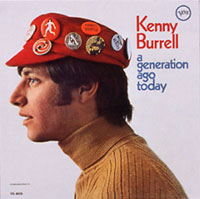 There you see that he's using tones from B Dorian[B, C#, D, E, F#, G#, A] until bar 6 arrives. There, he applies a mirror image to the phrasing he used in bars 3-4. Even 8th-notes in the odd-numbered bar and 8th-note triplets in the bar that follows. Bar 6 also uses the E altered dominant scale[E, F, G, G#, Bb, C, D]. It is the same relationship transposed up a 4th that he applied in bars 3-4. The triplet groupings continue throughout bar 7 and into bar 8. Though it's a little hard to hear, it seems that he actually goes all the way down to his open low 'E'-string. There you see that he's using tones from B Dorian[B, C#, D, E, F#, G#, A] until bar 6 arrives. There, he applies a mirror image to the phrasing he used in bars 3-4. Even 8th-notes in the odd-numbered bar and 8th-note triplets in the bar that follows. Bar 6 also uses the E altered dominant scale[E, F, G, G#, Bb, C, D]. It is the same relationship transposed up a 4th that he applied in bars 3-4. The triplet groupings continue throughout bar 7 and into bar 8. Though it's a little hard to hear, it seems that he actually goes all the way down to his open low 'E'-string.When one speaks of Kenny Burrell, it is impossible not to mention tone and touch. He has a really unmistakable sound on the instrument, and yes, some of it is in the nature of the various Gibson guitars he has chosen to play or the selection of an amp and its setting, but, more than these important elements, it is the way his left-hand and right-hand "romance a sound" from the instrument. That quality ends up being far greater than what might seem to be so obvious. Over the course of his many, many recordings as both a leader and a sideman, Kenny's sound has always been beautifully captured by engineer, Rudy Van Gelder. The sound they achieve has a certain 'bite' to it, but it is never brittle nor harsh. It is always warm, and full of soul. Then, you add in Kenny's natural sense of swing, his roots in the blues, and you have arrived at a most special voice in Jazz! It's so hard to believe that the great Charlie Christian died 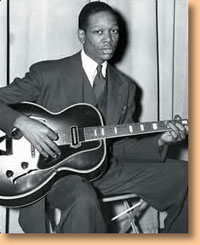 at the age of 25 from tuberculosis. Yet, he left behind such a powerful legacy that he influenced everyone who was to follow in his glorious footsteps. Kenny Burrell's tribute to him, and his brief time with Benny Goodman, included tunes associated with this duo such as: "As Long as I Live"(particularly beautiful here, because of the presence of Mike Mainieri's vibes and the bossa nova groove); "Seven Come Eleven"; "Rose Room"; "Wholly Cats"; "A Smo-o-o-oth One"; "Flying Home"; "I Surrender Dear"; and "Poor Butterfly." If you haven't taken the time to go back, and to listen to Charlie Christian, you will truly be amazed at how much Wes Montgomery, Kenny Burrell; Grant Green; and others you will hear in his very futuristic playing. He was so far ahead of his time. A great, great pity that he passed away at such a young age. at the age of 25 from tuberculosis. Yet, he left behind such a powerful legacy that he influenced everyone who was to follow in his glorious footsteps. Kenny Burrell's tribute to him, and his brief time with Benny Goodman, included tunes associated with this duo such as: "As Long as I Live"(particularly beautiful here, because of the presence of Mike Mainieri's vibes and the bossa nova groove); "Seven Come Eleven"; "Rose Room"; "Wholly Cats"; "A Smo-o-o-oth One"; "Flying Home"; "I Surrender Dear"; and "Poor Butterfly." If you haven't taken the time to go back, and to listen to Charlie Christian, you will truly be amazed at how much Wes Montgomery, Kenny Burrell; Grant Green; and others you will hear in his very futuristic playing. He was so far ahead of his time. A great, great pity that he passed away at such a young age.So now, do you see what I meant about the cover of "A GENERATION AGO TODAY"? What does that geeky "Mod" have to do with our Kenny Burrell? The art director was truly 'out to lunch' when he conceived of this cover! It has been a great pleasure to finally present a Kenny Burrell solo here at KHAN'S KORNER 1. I can't stress enough just how much he influenced what I have tried to become as a player. I don't believe that I could ever attain his sense of grace, dignity, and playful swing, but, I am certain that hearing those qualities in his work did rub off in some manner. He will always be one of my great heroes. Thanks Kenny!!
[Photo of Kenny Burrell by: Alfred Lion
Steve(*) with Kenny Burrell and Sammy Cahn in Tokyo, Japan ca. 1972] (*) Looking like René Descartes, or one of the Three Musketeers! |